
How to account for things when you own the building instead of renting it. Created by Sal Khan.
- Subject:
- Economics
- Social Science
- Material Type:
- Lesson
- Provider:
- Khan Academy
- Provider Set:
- Khan Academy
- Author:
- Sal Khan
- Date Added:
- 07/27/2021

How to account for things when you own the building instead of renting it. Created by Sal Khan.
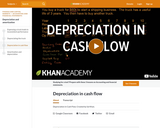
Depreciation in Cash Flow. Created by Sal Khan.
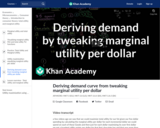
Where does a buyer's demand curve come from? A rational buyer wants to get as much "bang per buck" from their consumption as possible. In economics, that's called marginal utility per dollar spent. When the price of a good decreases, the "bang per buck" on that good increases, which incentivizes consuming more of it. In this video, we derive the individual's demand curve for a good by tweaking the marginal utility per dollar spent. Created by Sal Khan.

Describe different sociological models for understanding global stratificationUnderstand how studies of global stratification identify worldwide inequalities
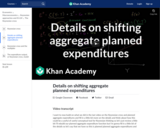
Showing how a change in government spending can lead to a new equilibrium. Created by Sal Khan.

This 10 minute video will teach students what identify theft is and the many ways it happens in our society. The video also offers ways to deter, detect and defend against identity theft. This video will aid in the mastery of standard EPF. 10 (k)
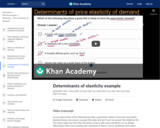
Walk through the logic of determining what kind of good has the most elastic demand in this video.
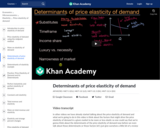
There are several factors that affect how elastic (or inelastic) the price elasticity of demand is, such as the availability of substitutes, the timeframe, the share of income, whether a good is a luxury vs. a necessity, and how narrowly the market is defined. We explore each of these in this video.
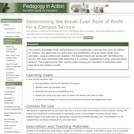
Students are asked to determine the break even profit point for a service to be offered on campus, using an online break even calculator.

This course provides rigorous introduction to core microeconomic issues in economic development, focusing on both key theoretical contributions and empirical applications to understand both why some countries are poor and on how markets function differently in poor economies. Topics include human capital (education and health); labor markets; credit markets; land markets; firms; and the role of the public sector.

Why are some countries rich and others poor? This fundamental question has been on the mind of economists since Adam Smith wrote "The Wealth of Nations" in 1776. This is a full course that covers all the major issues and developments in the field of development economics. Unlike typical college courses, we will take you to the frontier of the discipline, covering recent research as well as more established material. This course is non-technical and is accessible to a beginner. If you pass the final exam, you will earn our "Development Economics" certificate on your profile.

This course emphasizes dynamic models of growth and development. Topics covered include: migration, modernization, and technological change; static and dynamic models of political economy; the dynamics of income distribution and institutional change; firm structure in developing countries; development, transparency, and functioning of financial markets; privatization; and banks and credit market institutions in emerging markets.
At MIT, this course was team taught by Prof. Robert Townsend, who taught for the first half of the semester, and Prof. Abhijit Banerjee, who taught during the second half. On OCW we are only including materials associated with sessions one through 13, which comprise the first half of the class.
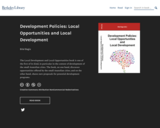
Short Description:
The Local Development and Local Opportunities book is one of the first of its kind, in particular in the context of development of the small Anatolian cities. The book, on one hand, discusses opportunities offered by the small Anatolian cities; and on the other hand, shares new proposals for potential development programs.
Long Description:
The Local Development and Local Opportunities book is one of the first of its kind, in particular in the context of development of the small Anatolian cities. The book, on one hand, discusses opportunities offered by the small Anatolian cities; and on the other hand, shares new proposals for potential development programs. The book, as the last in a series of new academic activities between 2016-2018, is related to development concerns in a self-organized small city in the Eastern Anatolia.
Word Count: 4270
(Note: This resource's metadata has been created automatically by reformatting and/or combining the information that the author initially provided as part of a bulk import process.)

This class surveys developmental entrepreneurship via case examples of both successful and failed businesses and generally grapples with deploying and diffusing products and services through entrepreneurial action. By drawing on live and historical cases, especially from South Asia, Africa, Latin America as well as Eastern Europe, China, and other developing regions, we seek to cover the broad spectrum of challenges and opportunities facing developmental entrepreneurs. Finally, we explore a range of established and emerging business models as well as new business opportunities enabled by developmental technologies developed in MIT labs and beyond.

This video is 2 minutes long and will define stagflation for students. It will enforce the standard EPF. 5 (b)

An introduction to the difference between wealth and income. Created by Sal Khan.

In this segment from Curious, learn about creating energy from solar rays to meet the growing energy needs of the world.

I find that when assigning lengthy readings for in-class discussion, it is extremely helpful to guide students' preparation with specific questions, and incorporate these in worksheets that explicitly call for students to write out their responses before entering the classroom. These worksheets can provide some added structure for whole-class discussion, or can provide a specific agenda for review of the readings in small groups. Because these readings are more than a few years old, I have also found it useful to assign small groups of students to give brief reports that expand on and update the issues raised in the readings.
(Note: this resource was added to OER Commons as part of a batch upload of over 2,200 records. If you notice an issue with the quality of the metadata, please let us know by using the 'report' button and we will flag it for consideration.)

Students are given a portfolio of investments, and they assess the relative risk associated with the products in their portfolios. They later determine which savings and investment instruments might be most suitable for clients of different ages and economic status.

This 3 minute video will explain the relationship between specialization and division of labor as defined in the 18th century by economist Adam Smith in The Wealth of Nations. This video will enforce standards EPF. 1 and 2